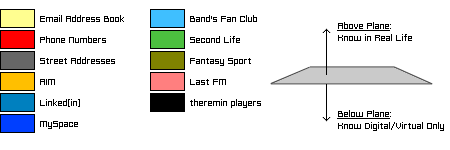Mobile AR, OOH and the Mirror World
 Sunday, June 6, 2010 at 6:44AM
Sunday, June 6, 2010 at 6:44AM The SlideShare above is the deck from my presentation at are2010 (Augmented Reality Event), at the Santa Clara Convention Center. It is titled Mobile AR, OOH and the Mirror World, and is partially based on my lengthier video, Mobile Augmented Reality, The Ultimate Game Changer, with more emphasis on marketing, and the implications on advertising business structure, with a focus on the convergence of mobile and OOH.
Synopsis:
There is a convergence well underway in the marketing/advertising world between mobile and OOH/DOOH marketing, that is being accelerated by a technological convergence between Mobile Augmented Reality and Mirror Worlds (3D mapping of the real world, such as Street View). This development is explored from several angles, including a thorough, but easy to understand explanation of the relevant technologies. Subplot: For structural reasons, the large-network advertising agencies are not responding to this development.
This 20 minute presentation was given on Thursday morning, June 3, to an audience of slightly over a hundred people. It was in the “Business Track” of the three-track event (the other tracks being “Technology” and “Production”).
I was pleased that the presentations of both Earthmine CEO, Anthony Fassero (in the technology track) and Blaise Aguera y Arcas, Keynote speaker from Microsoft Bing Maps, covered some of the same territory, giving some qualified backing to my projections on the future shape of convergence between Mobile AR and Mirror Worlds. Excerpts from their presentations are in the videos below. Speaking on Photosynth, Microsoft Bing’s Street-Side View and how Mirror Worlds and Computer Vision will provide the tight visual registration to reality needed for strong mobile AR… in his own words, “That’s really… at the core of the vision that we’re trying to pursue.”
Blaise Aguera y Arcas:
Anthony Fassero:
Sources, References & Inspirations:
Selected Research: Oxford
Georg Klein: Website of PTAM researcher.
PTAM: Parallel Tracking and Mapping.
Selected Research: University of Washington
Noah Snavely: Team Leader, now at Cornell.
Photo Tourism: Precursor to Microsoft Photosynth.
Company Links: DOOH:
TAB WorldMedia: OOH + Mobile Agency.
LocaModa: DOOH + Mobile Social Networks.
Quividi: DOOH Analytics.
Captivate: Elevator Video Displays.
GSTV: Gaas Station Displays.
RMG Networks: DOOH Network.
iDesign: DOOH ATM Network.
Company Links: Computer Vision & Mirror Worlds:
QderoPateo: Chinese launched AR mobile patform.
Zenitum: Computer vision software.
Microsoft LiveLabs: Home of Photosynth.
Google Earth: Google’s Mirror World.
Earthmine: Mirror World urban mapping.
EveryScape: Mirror World urban mapping.
Sources Links::
Juniper Research: Mobile AR revenue growth thru 2014.
Internet Advertising Bureau: PCs vs Mobile Phones.
RBC Capital Markets: PCs vs Smartphones.
App Store Links: iPhone Apps featured in slides:
Layar Reality Browser by Layar
Wikitude by Mobilizy
Bionic Eye by Presslite
App Store Link: Android App featured in slides:
Google Goggles by Google
Restaurants featured in AR demo: Slide 63:
Eleven Madison Park 11 Madison Ave. at 24th
Tabla 11 Madison Ave. at 25th





